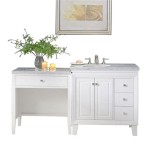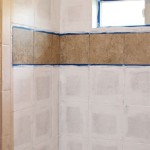How To Pick Out Bathroom Floor Tile
Selecting the right bathroom floor tile is a crucial step in any bathroom renovation or new construction project. The floor tile not only contributes significantly to the overall aesthetic of the space, but it also plays a vital role in functionality, safety, and long-term durability. A thoughtfully chosen bathroom floor can enhance the room's visual appeal, improve its slip resistance, and simplify cleaning. The process of selecting tile requires careful consideration of various factors, including material type, size, style, texture, water resistance, and budget. Navigating these choices can seem overwhelming, but understanding the key principles involved will empower individuals to make informed decisions that result in a beautiful, functional, and enduring bathroom floor.
The bathroom environment presents unique challenges compared to other areas of a home. High humidity, frequent water exposure, and the potential for spills require materials that can withstand these conditions without deteriorating or becoming hazardous. Furthermore, the confined space of most bathrooms necessitates careful planning to optimize the visual impact of the tile selection. Light colors can make a small bathroom feel larger, while larger tiles can minimize grout lines, creating a cleaner and more streamlined appearance. Ultimately, the ideal bathroom floor tile should be both aesthetically pleasing and perfectly suited to the practical demands of the space.
Consider Different Tile Material Options
One of the first and most important steps in selecting bathroom floor tile is to consider the various material options available. Each material offers a unique combination of properties, including durability, water resistance, cost, and aesthetic appeal. Familiarizing oneself with the advantages and disadvantages of each material is paramount to making a suitable choice for a specific project.
Ceramic Tile: Ceramic tile is a popular and cost-effective choice for bathroom floors. It is made from clay that is fired at high temperatures, resulting in a durable and water-resistant surface. Ceramic tile is available in a wide range of colors, patterns, and sizes, making it a versatile option for various design styles. It is relatively easy to clean and maintain, and it is resistant to stains and scratches. However, ceramic tile can be cold to the touch and may become slippery when wet, necessitating the use of textured tiles or rugs for added safety.
Porcelain Tile: Porcelain tile is a denser and more durable type of ceramic tile. It is fired at even higher temperatures than ceramic tile, resulting in a less porous material that is highly resistant to water absorption. This makes porcelain tile an excellent choice for bathrooms with high humidity and frequent water exposure. Porcelain tile is also more resistant to stains, scratches, and fading than ceramic tile. While it tends to be more expensive than ceramic tile, its superior durability and water resistance make it a worthwhile investment for many homeowners.
Stone Tile: Stone tile, such as marble, granite, slate, and travertine, offers a luxurious and natural aesthetic. Stone tile is known for its unique textures, colors, and patterns, which can add character and sophistication to a bathroom. However, stone tile is generally more expensive than ceramic or porcelain tile. It can also be more porous and susceptible to staining if not properly sealed and maintained. Regular sealing is essential to protect stone tile from water damage and stains. Furthermore, some types of stone tile can be slippery when wet, so choosing a textured finish or using rugs is recommended.
Vinyl Tile: Vinyl tile is a synthetic material that is known for its durability, water resistance, and affordability. It is available in a wide range of styles, including options that mimic the look of ceramic, porcelain, and stone tile. Vinyl tile is relatively easy to install and maintain, and it is comfortable underfoot. It is also resistant to scratches and stains. While vinyl tile is a practical choice for bathrooms, it may not have the same high-end aesthetic as natural stone or porcelain tile.
Glass Tile: Glass tile can add a touch of elegance and sophistication to a bathroom. It is available in a variety of colors, shapes, and sizes, and it can be used to create intricate patterns and designs. Glass tile is non-porous and resistant to water damage, making it a suitable choice for bathroom floors. However, it can be more expensive than other tile options, and it may require professional installation. Glass tile can also be slippery when wet, so choosing a textured finish or using rugs is recommended.
Evaluate Tile Size, Shape, and Style
The size, shape, and style of the bathroom floor tile significantly impact the overall aesthetic of the space. Careful consideration of these factors can create a visually appealing and harmonious design. The choice should complement the overall bathroom design theme, the size of the room, and the desired level of visual impact.
Tile Size: The size of the tile can have a significant impact on the perceived size of the bathroom. Larger tiles can make a small bathroom feel more spacious by minimizing grout lines and creating a cleaner, more streamlined appearance. Conversely, smaller tiles can add visual interest and detail to a larger bathroom. Standard tile sizes for bathroom floors include 12x12 inches, 18x18 inches, and 24x24 inches. Plank-style tiles that mimic wood flooring are also becoming increasingly popular. The chosen size should be proportionate to the size of the bathroom; overly large tiles in a small bathroom may appear overwhelming, while very small tiles in a large bathroom may look too busy.
Tile Shape: While square and rectangular tiles are the most common choices for bathroom floors, other shapes, such as hexagonal, octagonal, and mosaic tiles, can add a unique and decorative touch. Hexagonal tiles are particularly popular in vintage-inspired bathrooms, while mosaic tiles can be used to create intricate patterns and designs. The choice of tile shape should complement the overall design style of the bathroom, and careful planning is essential to ensure that the chosen shape is aesthetically pleasing and functional.
Tile Style: The style of the bathroom floor tile should complement the overall design theme of the bathroom. For example, a modern bathroom might benefit from sleek, minimalist tiles with clean lines and neutral colors. A traditional bathroom might feature stone tiles with natural textures and warm colors. A coastal bathroom might incorporate blue or green tiles with a subtle texture to evoke the feeling of the ocean. The style of the tile should also complement the other elements in the bathroom, such as the vanity, toilet, and shower. Cohesive design elements will enhance the perceived value of the room.
Grout Color: Grout plays a significant role in the overall appearance of the tiled floor. Selecting an appropriate grout color can enhance or detract from the appearance of the tile. Matching the grout color to the tile color creates a seamless and uniform look, which can make a small bathroom feel larger. Using a contrasting grout color can highlight the shape and pattern of the tiles, adding visual interest. Dark grout colors are often preferred in high-traffic areas or bathrooms with heavy use, as they tend to hide dirt and stains better than light grout colors. Epoxy grout is more resistant to stains and mildew than traditional cement-based grout, making it a good choice for bathrooms.
Prioritize Safety and Functionality
Beyond the aesthetic considerations, safety and functionality are paramount when selecting bathroom floor tile. The bathroom is a potentially hazardous environment due to the presence of water and the risk of slips and falls. Choosing tiles that provide adequate slip resistance and are easy to clean and maintain is essential to creating a safe and functional bathroom.
Slip Resistance: The slip resistance of a tile is measured by its coefficient of friction (COF). A higher COF indicates greater slip resistance. For bathroom floors, it is generally recommended to choose tiles with a COF of 0.5 or higher. Textured tiles, such as those with a matte finish or embossed surface, provide better slip resistance than smooth, glossy tiles. Small mosaic tiles with numerous grout lines also offer enhanced slip resistance. It is important to consider the slip resistance of the tile when wet, as this is the condition in which slips and falls are most likely to occur. If considering a very slippery tile, be sure to use rugs and mats for safety purposes or choose a non-slip coating.
Water Resistance: The water resistance of a tile is determined by its porosity, which is the amount of water it can absorb. Porcelain tiles are the most water-resistant option, followed by ceramic tiles. Stone tiles can be more porous and may require sealing to prevent water damage. Vinyl tiles are inherently water-resistant. Choosing tiles with low porosity is essential for bathrooms, as these tiles are less likely to absorb water and become damaged. Proper installation and sealing of grout are also important to prevent water penetration.
Maintenance and Cleaning: Bathroom floor tiles should be easy to clean and maintain. Smooth, non-porous tiles are generally easier to clean than textured or porous tiles. Regular cleaning with a mild detergent and water is typically sufficient to keep bathroom floor tiles looking their best. Avoid using harsh chemicals or abrasive cleaners, as these can damage the tile surface. Grout should be cleaned regularly to prevent the buildup of dirt and mildew. Sealing the grout can help to protect it from stains and water damage. Stone tiles may require periodic sealing to maintain their appearance and prevent staining. Consider the long term expense of maintenance, as it can add up over the lifetime of the flooring.
Budget Considerations: The cost of bathroom floor tile can vary widely depending on the material, size, style, and quality of the tile. It is important to establish a budget for the project and find tiles that meet the desired aesthetic and functional requirements without exceeding the budget. Ceramic and vinyl tiles are generally the most affordable options, while stone and glass tiles tend to be more expensive. Installation costs should also be factored into the budget, as professional installation can add significantly to the overall cost of the project. Comparison shopping and obtaining multiple quotes from different suppliers and installers can help to ensure that the best possible price is obtained.

Five Tips For Choosing The Best Shower Floor Tile Napolis Flooring

6 Tips For Choosing Bathroom Flooring

Guide To Selecting The Best Bathroom Floor Tiles For Your Home

How To Choose The Right Flooring For Your Bathroom Mission Kitchen And Bath

Top Tips For Choosing Bathroom Tiles Tile Mountain

How To Choose The Right Bathroom Floor Tiles Top Tips And S Homelane Blog

How To Choose Bathroom Tile Scott Mcgillivray

How To Choose A Bathroom Floor Tile Exquisitely Unremarkable

How To Choose Bathroom Floor Tiles The Galleria Of Tile

Bathroom Tile Ideas
Related Posts







